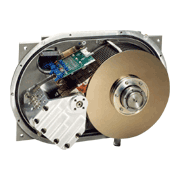The Electrical Communication Laboratories (ECL) of Nippon Telegraph and Telephone Public Corporation (now NTT) aimed to improve the performance and economy of file memory, which accounted for a large share of system cost, and in 1984 started development to increase the capacity and speed of magnetic disk units while developing the DIPS-11/5E Series. In 1986, they achieved practical application of a high-capacity, high-speed magnetic disk unit (commonly referred to as GEMMY: Giga-byte capacity magnetic memory).
GEMMY had the features indicated below. It had a memory capacity 2.8 times that of PATTY, which had one of the highest capacities in the world, and achieved world-class performance in terms of surface recording density, data transfer speed, and other characteristics.
- 1) While improving the performance of the thin-film magnetic disk developed for PATTY, the research center developed a new thin-film magnetic head for high-speed operation and thereby achieved a surface recording density of 62 Kbit/mm2 and a data transfer speed of 4.4 MB/s.
- 2) The performance of the floating head in following the disk surface was greatly improved by shortening it to 3.2 mm and making it lighter (1/2 the weight of the head in PATTY).
- 3) High track density was achieved by controlling mechanical vibration. This was done using a HDA with a symmetrical shell structure, and a dual-support spindle configuration.
- 4) High-speed positioning with an average seek time of 12 ms was achieved by using a compact dual-actuator employing new materials, and feedforward positioning control.
- 5) High-speed access was achieved via high-speed data transfer at 4.4 MB/s, dual actuator control, and improved functionality of dynamic cross-calling to ensure effective use of access paths.


